Catalogue number 44252
US Navy Submarine with a Martin MS-1 on deck
Between 1923 and 1926, the US Navy experimented with the use of a small observation and scouting seaplane carried and launched from a submarine. The Marin MS-1 biplane was carried in a water-tight container on the submarine's deck and once on the surface, the aircraft was to be quickly assembled and launched by balasting down the submarine until the seaplane could float off. This is the manoeuvre that we can see in the photograph of A-6325 floating off the submarine S1.
Verso: "here it is Eddie with the plane on the after deck this is the V2. please write and give me your opinion" in pencil
13.7cm x 7.9cm Gelatin silver print
|
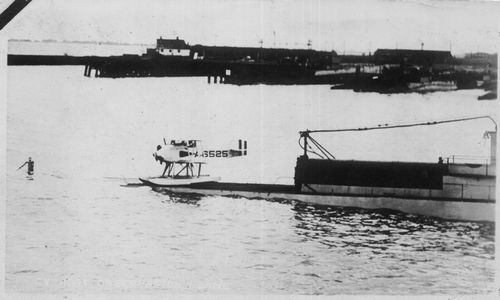 |
Catalogue number 96095, 31008, 66039, 95038 & 94090
Saunders-Roe SR.A/1
One. The Saunders-Roe SR.A/1 was a revolutionary, water-based aircraft with a top speed in excess of 500 mph. Construction began in 1946 to produce this single-seater, twin jet-propelled flying boat fighter. It had no official name and was referred to as the "Squirt" but the project came to an end in the early 1950s as the Squirt lost out in the competition with the new land-based jet fighters that were appearing on the scene plus the success in war of the aircraft carrier. Shown here is one of the three prototypes (TG263) with the initial Perspex bubble canopy. It had two Metropolitan-Vickers F.2/4 Beryl axial flow turbojets placed side by side in the fuselage and sharing the same nose air intake but with separate exhausts. Surprisingly, it is said that there was no problem with water ingestion but the SR.A/1 was not designed to operations in choppy seas.
Two. The first test flight took place on 16th July 1947 and the test pilot Geoffrey Tyson reported satisfactory handling of the flying boat both in the air and on water. Here, the flying boat is just sitting on the step of the planing hull.
Three. The SR.A/1 had semi-retractable floats to improve the aerodynamics. Each float first pivoted inwards through 90° before the arm folded into a well in the lower surface of the wing. This way, only the streamlined part of each float was exposed. In the first photograph, we can see the two dark bands of the pivoting mechanism on each float. In the lower photograph, we can see the orifice for the planed four nose-mounted Hispano 20mm cannons.
Four. TG263 was brought out of store in November 1950 and hydrodynamic tests recommenced, the last flight being in June 1951. Here we can see the underwing recess on the port wing and the float pivot points as two dark areas on the starboard float.
Five. After the initial trials, several modifications were made including replacement of the Perspex bubble canopy with a metal canopy and reducing the rudder horn balance as can be seen in this photograph. A short take-off could be attained - 26 seconds - by retracting the wing floats, and so reducing drag, once the aircraft had lateral stability.
One. Verso: "SR A1" in black ink
Two. Verso: "Britain has first jet flying boat fighter. 30.7.47. The first jet-propelled flying boat fighter in the world - the Saunders-Roe A1 - was successfully tested at Cowes, Isle of Wight, this afternoon. It is fitted with twin Metropolitan Vickers jet units known as the Beryl, but its maximum speed is a top secret. The picture shows the jet-propelled flying boat taking off on her trial flight to-day."
Three. Verso: "First flying boat tested. 31.7.47. The world's first jet-propelled flying boat fighter, the Saunders-Roe SR/A1 made its first …. appearance over the Solent yesterday, after …."hush-hush" test flights. It has ….a speed of more than 400m.p.h….in a pressurised cabin, and it….cannon. The pilot has an ejector seat."
Four. Verso: "1952" in pencil
Five. Recto: "Saunders-Roe Fighter Flying Boat A-52-C (sic)" Verso: Postcard franked 1953
One. 15.6cm x 10.5cm Gelatin silver print
Two. 21cm x 15.1cm Gelatin silver print
Three. 13.7cm x 19cm Gelatin silver print
Four. 7.2cm x 4.5cm Gelatin silver print
Five. 13.2cm x 8.2cm Gelatin silver print
|
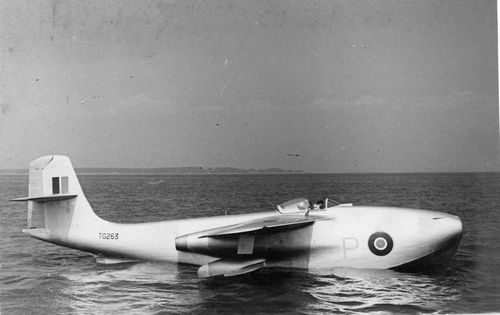 |
 |
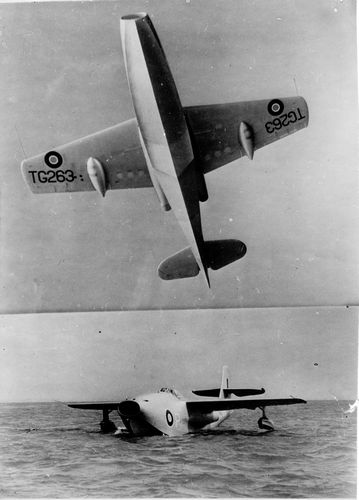 |
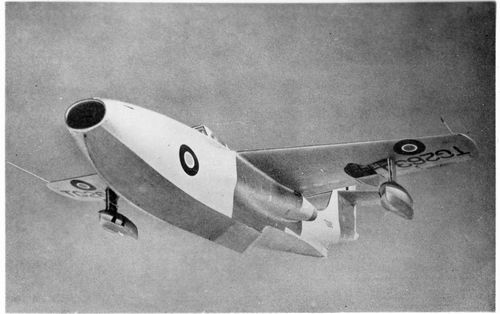 |
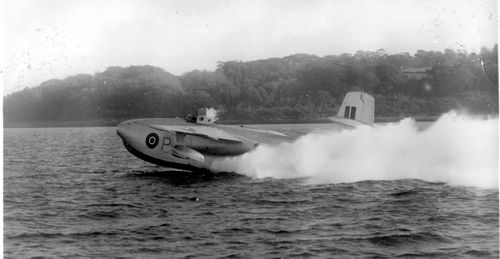 |
Catalogue number 40130
French Aéronavale Avro Lancaster, North Africa
Minds were not totally at rest with the end of World War II and European governments, notably France, feared a revival of German aggression such that in 1947, the United Kingdom and France signed a treaty of alliance and of mutual assistance in the event of renewed attacks. As the communist threat developed, the Benelux countries joined the United Kingdom and France to form the Western Union. As part of the agreement, 54 reconditioned Avro Lancaster bombers, with the serial prefix WU, were transferred to the French Aéronavale. Along with the RAF Coastal Command, they were to protect Atlantic shipping. The French aircraft were based in North Africa and this aircraft, WU09, joined the 2F squadron at Port-Lyautey on the Atlantic coast of Morocco in 1952.
Source: Aéronautique Navale
30cm x 22cm Gelatin silver print
|
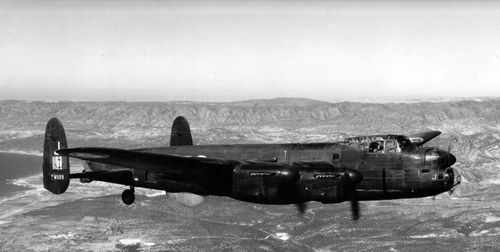 |
Catalogue number 88
French Aéronavale Lancaster WU40
The WU aircraft were modified for their new role of maritime reconnaissance with the addition of long-range fuel tanks, ASV (aviation surface vessel) radar (model APS-15) in a ventral dome and extra rear windows for observation whilst the dorsal turret was faired-over. The aircraft also carried Air-Sea Rescue equipment. We can see members of the crew looking out of the astrodome and the portside rear windows.
Source: Unknown
35cm x 25cm Gelatin silver print
|
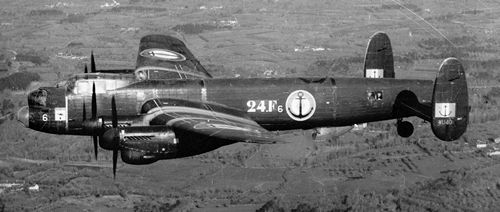 |
Catalogue number 52118
Armed French Aéronavale Lancaster, WU-46
A rather weather-worn Lancaster. We can see three dorsal aerials for the radar and a crew member is in the astrodome. Note the different size of the machine guns, this Lancaster has retained the forward twin 0.303-inch Brownings and the tail twin 0.5-inch machine gun turrets. As for the photograph number 40130, there appears to be some kind of shoot projecting from the rear turret, is it for releasing air-sea rescue gear?
Source: Unknown
24.1cm x 17.7cm Gelatin silver print
|
 |